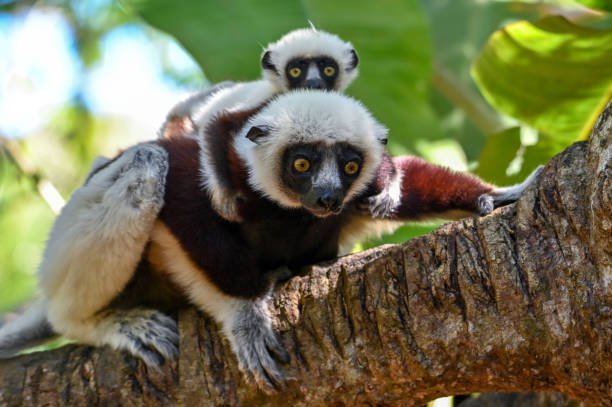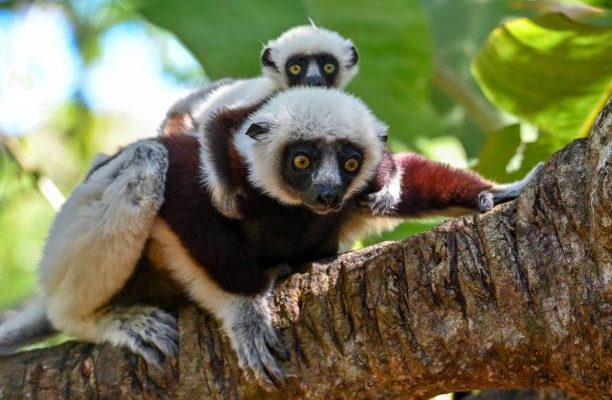
What is a Sifaka?
Sifakas are a type of lemur, and there are several species of them, including the famous Coquerel’s sifaka and the diademed sifaka. What sets them apart from other lemurs is their unique way of moving. They can’t simply hop or walk like most animals; instead, they glide between trees, using their powerful legs to launch themselves into the air. It’s a sight that seems almost magical!
These animals are not just skilled acrobats; they also have striking fur that can range from white to brown, often marked with unique patterns. Their large, expressive eyes give them a curious and endearing look. Each sifaka has its own *social structure*, often living in small family groups. They communicate through a variety of sounds, from loud calls in the trees to softer grunts and coos when interacting with family members. Isn’t it fascinating how their social lives mirror our own?
Sadly, all this charm and charisma are overshadowed by their conservation status. Let’s explore why these adorable creatures are considered endangered.
Why Are Sifakas Endangered?
Sifakas face a number of challenges that have led to their endangered status. One of the biggest threats is habitat loss. Madagascar is experiencing rapid deforestation due to logging, agriculture, and mining, which means these creatures are losing their homes at an alarming rate. Just think about it: when the trees come down, they lose not only their shelter but also their food sources.
Moreover, hunting is another significant threat. Unfortunately, some communities in Madagascar hunt sifakas for food or to capture them for the illegal pet trade. It’s heartbreaking, but many people might not realize the impact this has on the population.
Climate change plays a role too. Changing weather patterns and extreme weather events can disrupt their habitats further, making it even tougher for them to survive. In a nutshell, these charming animals are stuck in a perfect storm of threats that make their future uncertain.
The Current Conservation Status of Sifakas
The International Union for Conservation of Nature (IUCN) classifies many sifaka species as endangered or critically endangered. This isn’t just a label; it reflects the dire situation they find themselves in. The critical status indicates that if we don’t act soon, we might lose these beloved creatures forever.
Conservationists have recognized the urgency of the situation. For example, the Coquerel’s sifaka is listed as endangered due to its declining population driven primarily by habitat destruction. The situation is dire enough that national and international organizations are rallying to save them.
Understanding these classifications helps paint a clearer picture of what’s at stake. It opens our eyes to the broader implications of species loss, not just for the sifakas, but for Madagascar’s unique ecosystems.
Conservation Efforts: What’s Being Done?
Fortunately, there’s hope. Many groups are dedicated to saving sifakas and their habitats. For instance, the Madagascar Fauna and Flora Group works tirelessly to improve conservation strategies. They focus on protecting existing habitats through reforestation and creating protected areas where sifakas can thrive without constant human interference.
Reforestation is a key strategy. By planting trees in deforested areas, these organizations help restore the natural habitat that sifakas need. Another successful approach is raising local awareness about the importance of conserving wildlife. When communities understand how integral sifakas are to their ecosystem, they may become more committed to protecting them.
Moreover, ecotourism initiatives are being developed. By encouraging visitors to experience the beauty of Madagascar’s wildlife, there’s potential for funding conservation efforts while providing sustainable income for local communities. It’s a win-win situation that supports both biodiversity and the local economy.
Challenges Faced in Conservation
Even with these efforts, challenges abound. Funding can be inconsistent, meaning some projects lack the resources needed to be sustainable. There’s also the difficulty of changing long-standing practices. While education is essential, it takes time to shift perceptions and behaviors in local communities.
Another hurdle is the political climate in Madagascar. Political instability can hinder conservation efforts and create uncertainties in funding and implementation. In these situations, collaboration with international organizations becomes crucial but can often be complicated and slow-moving.
And let’s not forget the *global perspective*. Climate change is a universal threat, and as it worsens, Madagascar’s unique ecosystems—and with them, sifakas—are at risk. Addressing these overarching issues requires collective global action.
How You Can Help
You might be wondering, “What can I do to help the sifakas?” There are several effective ways to contribute to conservation efforts:
- Support conservation organizations: Donating to reputable groups that focus on Madagascar’s wildlife can make a direct impact.
- Spread the word: Raising awareness about the plight of sifakas within your social circles can create a ripple effect.
- Choose sustainable products: Being mindful of where your products come from can help reduce deforestation and protect natural habitats.
- Engage in ecotourism: If you travel to Madagascar, opt for eco-friendly tours that support local communities and conservation efforts.
Every small action matters. By taking steps to support conservation, you’re becoming part of a global effort to ensure that sifakas and other endangered species have a fighting chance.
The Future of Sifakas: A Ray of Hope
While the situation for sifakas is serious, there’s still hope. Conservation efforts are gaining momentum, and the growing awareness of the importance of biodiversity means more people are rallying behind the cause. The vibrant communities in Madagascar are beginning to embrace practices that prioritize preserving their unique wildlife.
As more initiatives take off, there’s potential for positive change. If we can continue to protect their habitats and educate local populations, we may very well see sifakas jumping and gliding through their forests for generations to come.
In the end, caring about sifakas is about more than just one species; it’s about preserving the incredible biodiversity of our planet. Let’s work together to ensure these enchanting dancers of the forest continue to thrive.

